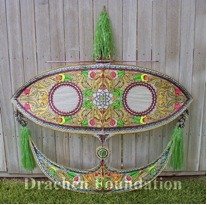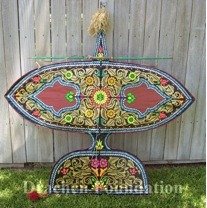Post by Marina Hernandez, Collections Intern
With its delicate paper form and its intricate floral designs, the Malaysian Wau kite is visually enchanting. Despite its beauty, the Wau is far from passively decorative. Steeped in history and tradition, Wau fly high and gracefully, producing a humming sound created by a noisemaker known as a hummer. The largest are five feet by four feet and require two people for launching. These can fly as high as 450 meters, almost 500 yards.

2007-08-K-00600
This Wau Bulan, or "moon kite," has the traditional style of solid colored areas on either end to represent eyes for navigating the spirit region.
Pronounced, "wow", the word wau is the Northern Malaysian name for kite, which likely comes from the Dutch word for a large fork-tail bird that is typical of Southeast Asia. Other speculations exist regarding the origin of the name. Some claim an early westerner in Malaysia exclaimed "wow" upon witnessing the beauty of the kites. Others explain that the shape of the kite resembles an Arabic letter that is pronounced, "wow."
Legends relating to Wau center around their ability to travel to the spirit world. According to the play Dewa Muda, a young prince is able to reach the princess of the Spirit King in her sky palace with the help of a magical golden kite, or Wau Emas. In another legend, a farmer and his wife adopt an abandoned baby. Jealous of her husband’s love for the new daughter, the wife eventually chases the girl from their home. Soon after, the crops fail. A fortune teller advises the couple to atone by building a Wau Bulan, or "moon kite," to communicate with the spirit world. Upon doing so, the harvest returns. Regional farmers continue this tradition today, displaying kites as a form of respect to the spirit region in hopes of receiving favorable growing conditions.

2007-08-K-00594
This Wau Kuching, or "cat kite," demonstrates the "day-glo" colors that are commonly used to decorate Malaysian kites. Here the eyes are represented by the solid red areas on either end.
Although the design of each kite varies by kite maker, the patterns typically consist of flower and leaf motifs, created by overlapping translucent, glazed-tissue paper. According to traditional design, blank space is left in the center of each wing. These areas represent the eyes of the kite, making it possible to navigate the spirit world. The frame generally consists of a type of bamboo known as Buluh Duri. Most Wau are also equipped with a noise-making bow called a busur or hummer that emits a high-pitched sound when the kite is in the air. The sound represents the life that the kite receives once it is flying in the air. The hummer also serves the practical purpose of making the kite more aerodynamic.
There more than twenty different varieties of Wau kites, but the Wau Bulan is the most common. It is known as the "moon kite" for its curved, crescent moon shape. Currently, the Drachen Foundation has more than ten Wau kites in its collection, including a recently acquired Wau Bulan. This new acquisition is a gift of Len Ainsworth, who donated five kites of Japanese, Chinese, and Malaysian origin to the Drachen Foundation this month.

2010-05-K-01431
This newly acquired Wau Bulan highlights the intricate craftsmanship required. Each pattern is pasted onto solid colored tissue paper, creating layers of delicate design.
Sources: Hosking, Wayne. Kites of Malaysia: Kites to Make and Fly. Kuala Lumpur, Malaysia: Malaysia Airlines, 1990.
http://www.usu.edu/masa/selection.html
http://www.kiteman.co.uk/MalaysianCollection%20.html

